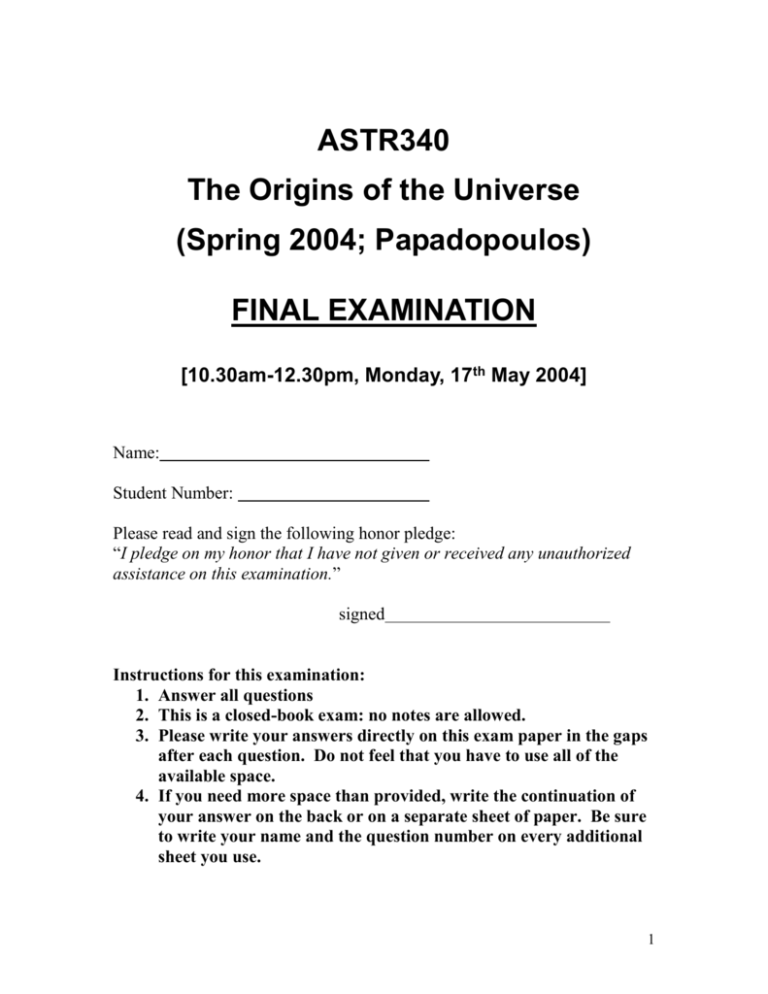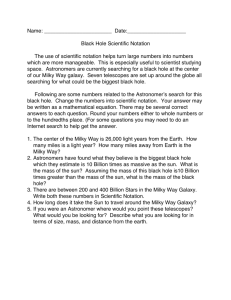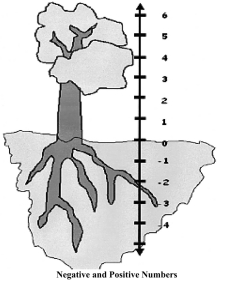ASTR340
advertisement

ASTR340 The Origins of the Universe (Spring 2004; Papadopoulos) FINAL EXAMINATION [10.30am-12.30pm, Monday, 17th May 2004] Name: Student Number: Please read and sign the following honor pledge: “I pledge on my honor that I have not given or received any unauthorized assistance on this examination.” signed Instructions for this examination: 1. Answer all questions 2. This is a closed-book exam: no notes are allowed. 3. Please write your answers directly on this exam paper in the gaps after each question. Do not feel that you have to use all of the available space. 4. If you need more space than provided, write the continuation of your answer on the back or on a separate sheet of paper. Be sure to write your name and the question number on every additional sheet you use. 1 SECTION A (35 points) Problems 1-5, four points each. Problems 6-8, five points each. Problem 1 An inertial frame of reference is one in which (a) an object has no inertia; (b) every object is either stationary or moving with constant velocity; (c) Newton’s first law of motion is valid; (d) no object can rotate. b Problem 2 If the gravitational attraction between the Earth and the Moon were nullified at the time of new Moon without making any other change in the solar system, the Moon would (a) gradually escape from the solar system; (b) strike the Earth; (c) move inward and strike the Sun; (d) follow a slightly eccentric orbit around the Sun similar to that of the earth. d Problem 3 If the Sun’s rotation were stopped, (a) the orbits of planets would be changed markedly; (b) the orbits of planets would remain the same; (c) the pattern of the seasons on Earth would be changed; (d) tides on the Earth would cease. b Problem 4: Newton’s law of gravity says that force is proportional to what power of the distance (d) separating the two bodies? a) d2 b) d1 c) d-1 d) d-2 X e) d-3 Problem 5: In a white dwarf the force exerted by its mass is balanced by a) Gaseous pressure b) Electron degeneracy X c) Electromagnetic force d) Neutron degeneracy e) Strong force. 2 Problem 6: State the Cosmological Principles. Briefly describe one piece of observational evidence that supports the validity of one of these Principles. The Universe is Homogeneous and Isotropic. Isotropy is supported by the measurements of the Cosmic Background Radiation (CRB). The CBR has been measured more recently by the COBE explorer and found to be isotropic to better than 10-6 and representative of the spectrum of Blackbody radiation at 2.735 K with an uncertainty of .01 K. Problem 7: Suppose the Sun were to suddenly and magically turn into a black hole (without changing its mass in the process). What would happen to the orbit of the Earth? In other words, would the orbit of the Earth spiral into the black hole, fly into space, or remain unchanged? Briefly justify your answer. The orbit of the earth will be unaffected, since the gravitational force depends only on the total mass of the Sun and the distance of the earth from the center of the sun and both are unchanged. Problem 8: In the space below, sketch a graph of how the scale factor changes as a function of cosmic time for the three possible “standard models” of the universe. Remember to label the axes of the graph, as well as the three cases you plot. Neglect the effects of dark energy (i.e. =0) See Figure 11.2 of book R k=-1 k=0 k=+1 t 3 SECTION B (65 points) Problem 9. This problem concerns black holes 1. [5 points] Observations with radio and X-ray telescopes reveal that there is some amount of radiation being emitted from the vicinity of this black hole. What do we believe gives rise to this energy source? Describe the process. The process is known as accretion and the observed body is an accretion disk. It is a disk of gas that accumulates around the center of strong gravitational attraction such it exists in the ergosphere of a rotating black hole. As the gas spirals into the black hole is frictionally heated to high temperatures with characteristic emission in the X-ray range. Most often this process occurs in binary systems one of which is a black hole that siphons gas from the other. 2. [10 points] Suppose you are in a spacecraft hovering at some distance above this black hole. You tie a clock to a rope and start lowering the clock towards the black hole. Describe how the rate at which you see the clock “tick” changes as it is lowered towards the black hole. Be sure to highlight the significance of the event horizon in your answer. Try to use a plot that shows the change in the duration of time length t in relation to my tick labeled as to as a function of the distance R from the center of the hole. As the clock is lowered into the black hole I will see the signals arriving at pre-described intervals to start arriving at longer and longer periods due to the gravitational redshift. The ticks will continue to slow down as the clock approaches the event horizon, but I will not see it crossing the event horizon. The time will seem to stop for the clock as it approaches the event horizon and radio beacon signal of the clock is redshifted away. At some point a last, highly redshifted signal arrives and nothing afterwards. From invariance of the Schwarzschild metric (1 RS / R)c 2 t 2 ( R) c 2 t o2 and t ( R) t o 1 RS / R 4 t(R)/to 1 1 R/RS GRADING – 5 points for correct description. 3 points for use of formula as time or frequency redshift. 2 points for graph ( Give 5 points for graph even without formula). 3. [5 points] You notice that, even though you are lowering the clock straight into the black hole, there is an apparent force that is trying to make the clock orbit around the black hole. This effect becomes stronger and stronger as the clock gets closer and closer to the black hole. When the clock gets sufficiently close (but still somewhat outside of the event horizon), this effect becomes irresistible. Despite your best efforts, the rope breaks and the clock spirals into the black hole. What is going on? The hole is a rotating or Kerr black hole. As soon as the clock crosses the static surface and enters the ergosphere it cannot remain motionless. The black hole compels the clock to participate in its rotation. Inside the static surface even light even light is dragged around the black hole. While the light cone is constantly tipped as we approach and enter the static surface we still receive the signals. Problem 10: (20 points) Describe all the types of redshifts that are measured in the Universe. For each one a. Describe the physical origin b. Give an example of its occurrence c. Show the equation that describes it (Make sure to define the symbols in the formulas) Definition of redshift factor z=rec-o)/o I. Doppler shift due to motion of source with respect to observer. Hydrogen lines received on the earth from the Sun. Whistle of an approaching or receding train. For non-relativistic speeds z=V/c where V is the radial velocity. 5 2. Gravitational Redshift: It occurs in regions that the strength of gravity near the source is larger than the in the observer’s region. For example reaching us from 1 an accretion disk. z 1 . Rs is the Schwarzschild’s radius. 1 Rs / R 3. Cosmological Redshift: It is due to the expansion of the Universe. It only occurs between galaxies but not inside a galaxy. For example radiation we receive from Quasars. z=Ro/R-1, where Ro is the value of the scaling factor at the time of reception and R at the time of emission. Grading: 7 points for each correct answer. In each answer 4 points for correct description, 2 points for example and point for formula. Problem 11: (15 points) Consider the Universe model shown in the figure below. At time t1 a star in a galaxy X emits the line of an element with wavelength measured in the laboratory of .1 micron. What will be the wavelength of the line for i. An observer that receives it on the surface of a planet located in another galaxy Y at time t2. ii. An observer that receives it at the same time t2 but at the center of the galaxy Y at a distance R=3/4 RS from the center of black hole. iii. For an observer that receives it in a galaxy Z at time t3 when the Universe is expanding at a rate R/t=.1 c. R/Ro Rt=.1c 2.1 2 1 t1 t t t3 6 The wavelength will be given by rec=(z+1)o In the first case the value of z is z1=R(t2)/R(t1)-1=2-1=1 Therefore rec=2o=.2 m In the second case in addition to the cosmological redshift we have to add the Gravitational” redshift” since the observer is located near a black hole. Notice, however, that in fact this will be blue shift, since the photon is coming and accelerated towards the black hole. As a result the total value of z will be the value of z1 above minus the value of z caused by the black hole which is z 2 1 / 1 RS / R 1 1 . As a result of the two exactly opposite effects the observer will receive un-shifted radiation of .1 m. In the last casethere will be a cosmological shift and a Doppler shift since the Universe is expanding at .1c. It is sufficient to use the non-relativistic formula so that the Doppler shift will have a value of z3=.1, while the cosmological redshift in this case will be is z1=R(t3)/R(t1)-1=2.1-1=1.1. The total value of z will be 1.1+.1=1.2 and the received radiation will have a wavelength of 1.2 m. Problem 12: (10 points) Describe the Olbers’ paradox and its resolution. Olbers in 1983 questioned the fact that if the Universe is infinite the night sky should bright, as bright a s the surface of a star, since the line of sight of an observer will always terminate on the surface of a star and the 1/R2 reduction of the light intensity with distance will be compensated by the fact that the solid angle that we receive radiation increases with distance as R2. Since the extinction due to the interstellar medium is small the night sky should be very bright. The paradox is resolved in the expanding Universe model, since redshifting brings the radiation to well below the visible band as well as by the fact than even in an infinite Universe light from very distance objects has not yet reached us due to the finite speed of light. 7 8 9






